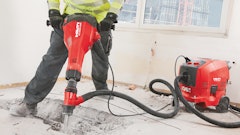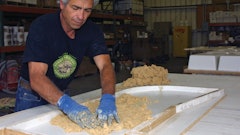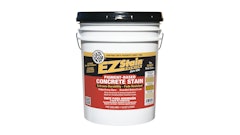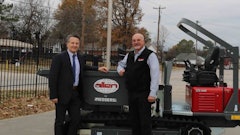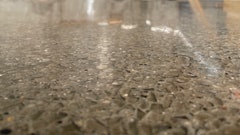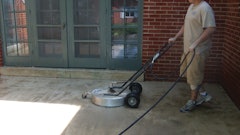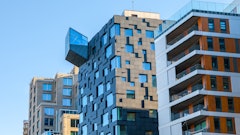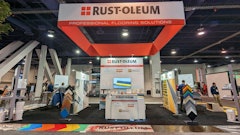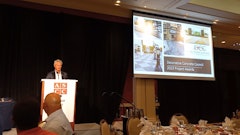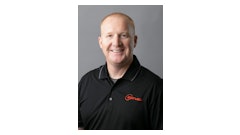
I describe to creative owners or architects that when an overlay is placed on a slab the old is gone, a new clean canvas is available to accept its proposed new vibrant space with total design flexibility. Meeting the clients expectations hinges on the aggregate effort of a great design, a creative applicator, vetted techniques, and proven product choices. New colors and textures are part of what make great spaces unique.
Self-leveling Overlays
There are many facets of overlay or wear surface toppings to discuss if a slab is a candidate for self-leveling, smoothing compounds, isolated patching or skim coating. Let's explore the path of the self-leveling or self-smoothing, wall-to-wall option for a complete space remodel with color as a top priority. When using a wall-to-wall overlay, designers are not constrained by the old slab and its past lives. Stains, saw cuts, abuse, poor initial concrete installation do not need to be part of the new spaces story. Full overlays allow for nearly seamless transitions into making a new space. They also should be valued as a capital improvement to the structure being renovated.
The raw overlay material is an important first step in choosing a direction for design. Let's consider final color goals: For brighter colors like yellows and reds using a white portland base or lighter color material helps with the vibrancy. Ardex Engineered Cements offers a white overlay material (PCT White), while Mapei (Ultratop) and CTS Rapid Sets (Tru) raw color is lighter than many grey overlay materials and will provide an accepting canvas for color.
The overlay industry has two major mix types or designs of overlay products. Polymer modified material and cementitous. Each mix type has its own unique tendencies or quirks when installing as a finished floor. Often those same tendencies or quirks are much more evident when adding dye or color. Some of these quirks to watch out for include: stripes or lines from the smoother being pulled across the floor; color shifts batch to batch from seemingly miniscule water variances in the mixes or uneven airflow through the space as the overlay cures are just a few honorable mentions.
I find clients often are excepting of a less than perfect uniform look if they are explained at the start of any project that their floor is going to be hand made and colored. Over hundreds or thousands of square feet, some variances are going to be evident, especially when it comes to adding colors. I always suggest a large sample area (10’x10’ minimum) be installed on site prior to approving colors. As each unique applicator or concrete artist’s techniques may vary ever so slightly, it is often difficult to see what the finish surface will look like with a small handheld sample or submittal. This in-place sample also gives the installer an opportunity to show some of the installation field variances that may occur so that the owner expectations are properly met.
Polymer Overlays
Polymer overlays have a tendency to form a film or skin on the surface as they cure. This skin must first be ground off to expose the body of material. The polymer skin on the surface will not allow color to penetrate effectively. Once the surface has been “opened up” the body of the polymer design is still an extremely tight matrix when compared to conventional concrete. This means that color is not readily accepted, especially as the topping cures and strength increases over its initial first few days after placement. My rule of thumb with dyes or stains on polymer toppings: cut soon and dye or stain soon to get as much color as deep as possible. Cementitious overlays react more like conventional concrete when dyeing or staining. The more porous nature of this mix chemistry accepts color and reacts with densfier and hardening agents more quickly and completely.
Integral Color
Adding color into the mix to create an integral topping is sometimes a chosen method among experienced contractors. Specific binders (usually polymers) are used when color is added to the mix water. These pigments are provided in either powder form and are water wettable or are shipped as liquid colorant. When adding color to the mix water, we have found the best, most uniform color from batch to batch is to create a water/dye holding tank to draw from. It is important to keep this water circulating throughout the entire project. The specific gravity of the pigments is heaver than that of clean water. The pigment will fall out of suspension and rest in the bottom of the tank. Having a small circulation pump running in the bottom of the tank will keep an even color throughout the pour. It has been found that color added to some chemistries of engineered toppings interfere with the mix design. Engineered cement is specifically designed with an exact water cement ratio (some products have a larger workability window than others). If you are considering integral coloring, always contact the manufacturer and discuss best practices with their product. If the manufacturer doesn’t have first hand experience with a pigment supplier or provide their own colors, don’t be a guinea pig!
When it comes to colored overlays and renovating space the number one goal of a contractor should be the management of expectations from the onset. Every designer has “seen a floor” they can’t wait to incorporate into their next project. Usually the colored polished concrete floor their heart is set on came with a great plan and healthy price tag. Trying to cut corners and save dimes on a colored overlay will always cost dollars to repair at the contractors expense if the initial goals or expectations are not in alignment with a solid specification and plan.
Ed. Note: Ryan McBride is a consultant at Polished Concrete Consultants, LLC. He can be reached at [email protected].









